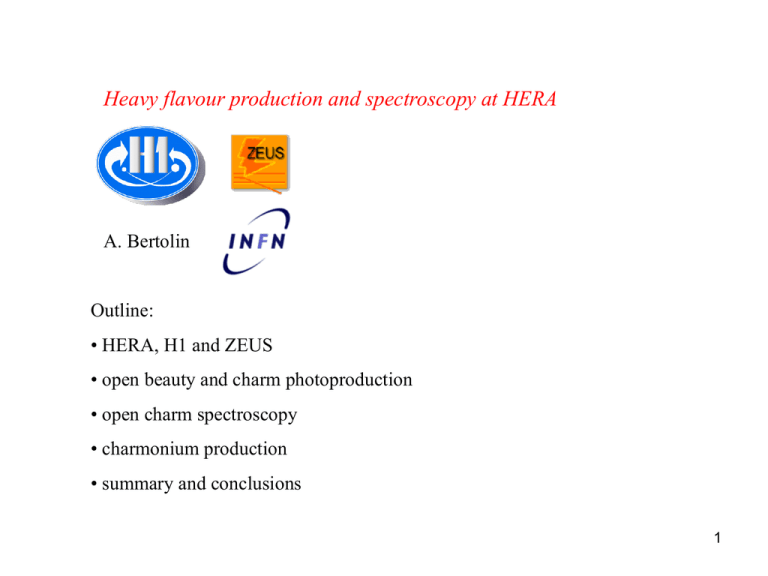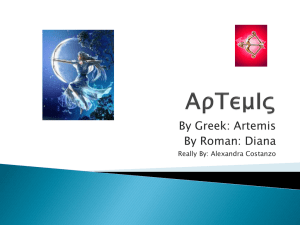slides
advertisement

Heavy flavour production and spectroscopy at HERA A. Bertolin Outline: • HERA, H1 and ZEUS • open beauty and charm photoproduction • open charm spectroscopy • charmonium production • summary and conclusions 1 HERA, H1 and ZEUS: a brief introduction • e p collider at high CMS energy (like having an about 50 TeV e beam on fixed target) • two large multipurpose experiments: H1 and ZEUS • running ended mid 2007 after about 2500 days of activity and 470 pb-1 of integrated luminosity per experiment 2 Open beauty and charm production at HERA main process: • direct g • boson gluon fusion • 0.8 < xg obs <1 key points: • mQ (or ETjet …) >> LQCD region of applicability of pQCD • collinear vs. kT parton dynamics other processes: • resolved g processes • 0 < xg obs < 0.8 • photoproduction (PHP) regime scattered electron is undetected Q2 < 1 GeV2 3 Open beauty and charm PHP at HERA fully inclusive beauty tag with 2 jet events Significance = d / sd • exploits the large lifetime of b/c hadrons with respect to light hadrons • silicon microvertex detector to have a good measurement of d • can measure beauty AND charm at the same time 4 Open beauty and charm PHP at HERA fully inclusive beauty tag with 2 jet events • xg obs peaks at 1 BGF is dominant • what is called resolved-g in the Pythia collinear MC is also reproduced in the Cascade kT MC without the need of a resolved-g component … • NLO QCD had is slightly underestimating the data for beauty but NLO QCD is as good for charm as for beauty … scale set by the jets pt 5 Open beauty and charm PHP at HERA beauty tag with two jets and one associated semileptonic electron bkg enriched b enriched c enriched likelihood function based on 5 discriminant variables: • dE/dx • EEMC / ECAL • ECAL / ptrack • electron pt w.r.t. the associated jet axis • azimuthal angle difference between the electron and the missing transverse momentum vector (// for signal) 6 Open beauty and charm PHP at HERA beauty tag with two jets and one associated semileptonic electron beauty • NLO QCD is as good for charm as for beauty charm • PYTHIA gives a fair description of the shapes but the normalization is significantly wrong … missing NLO corrections … 7 Open beauty PHP at HERA beauty tag with D* + m (no jets) beauty charm unlike-sign D* m unlike-sign D* m beauty like-sign D* m 8 Open beauty PHP at HERA • many very different experimental methods in fair agreement • can measure down to <pTb> ~ 5 GeV (~ mb) and up to ~ 25 GeV • data are already as precise as theory … need more accurate theoretical predictions • most recent points are right on top of the NLO predictions … 9 Open charm production at HERA charm spectroscopy at HERA: 10 Open charm production at HERA basic building blocks: D* K p ps D* K p p ps D0 K p D K p p 11 Open charm production at HERA: D* cross sections • Pythia collinear massive fails • Pythia collinear mass less fails (except for h) • Cascade kT fails (except pt shape) • NLO is quite reasonable except for h>0 lots of beautiful data but theory is poor … may be NLO is on the right track … 12 Open charm production at HERA excited charm mesons: D01 / D*02 D* p excited charm strange mesons: D s1 D* K0s in this particular decay mode difficult to separate D01 and D*02 D*02 D p due to spin parity conservation D01 can NOT decay in this mode D s1 D0 K 13 Open charm production at HERA tabular summary: • hopefully errors will be reduced extending the analysis to HERA II data and using microvertex detector data (available also for ZEUS in HERA II) • the HERA rates are in reasonable agreement with those measured in others (e+ e-) experiments 14 Charmonium production at HERA (y(1S) and y(2S)) direct g CO model • this particular diagram: 0.2 < z < 0.9 • more “typical” ones: z > 0.9 direct g CS model 0.2 < z < 0.9 p-rest frame: z = E(y)/E(g*) open issues: • size of the CO contributions resolved g CS model z < 0.2 • collinear vs. kt parton dynamics (as in the CASCADE MC) 15 Charmonium production at HERA (y(1S) and y(2S)) • < 1/10 of the total available luminosity • y(2S) to y(1S) cross section ratio consistent with being flat • y(2S) y(1S) ( m m) X contribution NOT subtracted from the data … not easy experimentally ! • 15 % increase of the J/y cross section other contributions: • diffractive charmonium: suppressed restricting the z – pt(J/y) phase space • charmonium from B mesons decay: much smaller than at TEVATRON • c contribution: tiny at HERA 16 J/y cross section measurements PHP regime: • NLO CS calculation with LARGE scale uncertainties describes the shapes • LO CS + kt factorization (CASCADE) describes the data well • LO CS + collinear factorization (EPJPSI) fine in shape DIS regime (3.6 < Q2 < 100 GeV2): • no NLO prediction • LO CS + kt factorization (CASCADE) describes the data well • LO CS + collinear factorization (EPJPSI) fine in shape 17 J/y cross section measurements PHP regime DIS regime ds/dp2T for different z rages d2s / dp2T dz • should be a stringent test of the matrix elements involved … would be nice to have NLO predictions as well … • LO CS + kt factorization (CASCADE) describes the data well 18 J/y helicity at HERA • helicity: study of the m+ angular distributions in the J/y rest frame learn about production channels • contrary to TEVATRON at HERA mostly “prompt” J/y … cleaner environment • can measure 2 out of 3 helicity parameters (l, n) BKV collinear factorization Baranov CS LO CS kt factorization • large differences in the predictions (sign is different …) • none of the predictions is able to describe simultaneously all measurements … 19 Conclusions • several beauty inclusive measurements have been performed and will be refined in the immediate future … almost fully reconstructed final states (like D*+ m ) have also been measured • measurements are not easy due to the small beauty cross section at HERA • remarkably enough all measurements are giving a rather consistent picture on the experimental side • in general beauty production is reasonably well described by NLO even at small pTb • charm and charmonium states are produced copiously at HERA • inclusive as well as precise exclusive final state measurements are available … can also perform charm spectroscopy at HERA • in the presence of a reasonably large scale (ETjet >> mC) NLO QCD is as good for open charm as for open beauty • charmonium production at HERA is well described by the CASCADE MC with kT factorization … but polarization is not well described … looking forward to better theoretical predictions … 20 Heavy flavour production and spectroscopy at HERA • Alessandro Bertolin (Padova) "Heavy flavour production and spectroscopy at HERA" • Lorenzo Bellagamba (Bologna) "Search for new physics at HERA" • Jan Figiel (Inst. of Nucl. Physics, Krakow) "Measurements of diffraction at HERA“ • Hans-Christian Schultz-Coulon, Heidelberg University "Structure Function Measurements at HERA" • Guenter Grindhammer, MPI Munich "Jet Production and alpha_s Measurements at HERA" 21




